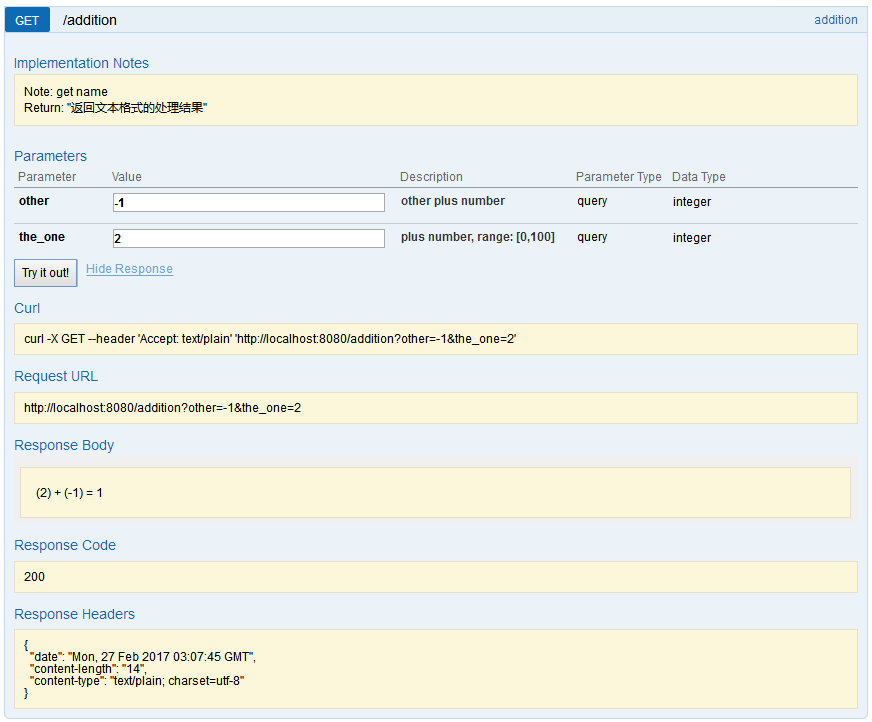操作与中间件 - Swagger2.0在线API文档
优质
小牛编辑
190浏览
2023-12-01
4.3 Swagger2.0在线API文档
API文档信息可以从两个地方获取,一个是struct Handler的字段标签中定义,一个是通过实现APIHandler接口来定义。
APIHandler接口定义的相关源码:
type (// Handler is the main Faygo Handler interface.Handler interface {Serve(ctx *Context) error}// APIHandler is the Faygo Handler interface,// which is implemented by a struct with API descriptor information.// It is an intelligent Handler of binding parameters.APIHandler interface {HandlerAPIDoc}// APIDoc provides the API's note, result or parameters information.APIDoc interface {Doc() Doc}// Doc api informationDoc struct {Note string `json:"note" xml:"note"`Return interface{} `json:"return,omitempty" xml:"return,omitempty"`Params []ParamInfo `json:"params,omitempty" xml:"params,omitempty"`}// Notes implementation notes of a responseNotes struct {Note string `json:"note" xml:"note"`Return interface{} `json:"return,omitempty" xml:"return,omitempty"`}// ParamInfo is the request parameter informationParamInfo struct {Name string // Parameter nameIn string // The position of the parameterRequired bool // Is a required parameterModel interface{} // A parameter value that is used to infer a value type and as a default valueDesc string // Description})
4.3.1 函数类型Handler定义API信息
通过使用函数faygo.WrapDoc()封装,为func Handler添加API文档信息,得到满足APIHandler接口的对象:
// 参数fn为预增加API信息的Handler函数,// 参数note是API接口说明,// 参数ret为API返回结果示例,// 不定参parms为API请求参数信息func WrapDoc(fn HandlerFunc, note string, ret interface{}, params ...ParamInfo) Handler
示例:
var AdditionHandler = faygo.WrapDoc(// Handlerfaygo.HandlerFunc(func(ctx *faygo.Context) error {// 获取请求参数,并作类型转换var a, b intif err := ctx.BindBizParam(&a, "the_one"); err != nil {return err}if a < 0 || a > 100 {return ctx.String(406, "参数 the_one 超出 [0,10] 的范围")}if err := ctx.BindBizParam(&b, "other"); err != nil {return err}return ctx.String(200, "(%s) + (%s) = %d", ctx.QueryParam("the_one"), ctx.QueryParam("other"), a+b)}),// API接口说明"addition",// 响应说明或示例"返回文本格式的处理结果",// 定义参数faygo.ParamInfo{Name: "the_one",In: "query",Required: true,Model: int(2), // API文档中显示的参数默认值Desc: "plus number, range: [0,100]",},faygo.ParamInfo{Name: "other",In: "query",Required: true,Model: int(-1), // API文档中显示的参数默认值Desc: "other plus number",},)
运行服务后打开API在线文档:
http://localhost:8080/apidoc
测试该API接口:

4.3.2 结构体类型Handler定义API信息
struct Handler的API信息涉及到两个地方:
- 结构体字段的标签,既用于绑定验证参数,也用于API信息的生成
- 通过定义Doc方法实现APIHandler接口,在字段标签信息的基础上对API信息进行补充
将4.3.1中func Handler改写成struct Handler:
type Addition struct {// <in:query> 定义query类型请求参数;// 参数名为字段名转为默认的snake格式(默认格式可自定义),即'the_one';// 该参数值会被自动转为int类型;// <range: 0:100> 当其大小不在[0,100]范围时,faygo自动返回错误,错误模板可以自定义;// <desc:plus number> 定义参数描述为'plus number'TheOne int `param:"<in:query> <desc:plus number> <range: 0:100>"`}// 实现Handler接口func (a *Addition) Serve(ctx *faygo.Context) error {var b intif err := ctx.BindBizParam(&b, "other"); err != nil {return err}return ctx.String(200, "(%d) + (%s) = %d", a.TheOne, ctx.QueryParam("other"), a.TheOne+b)}// 补充API文档信息func (a *Addition) Doc() faygo.Doc {return faygo.Doc{// API接口说明Note: "addition",// 响应说明或示例Return: "返回文本格式的处理结果",// 补充参数定义Params: []faygo.ParamInfo{{Name: "other",In: "query",Required: true,Model: int(-1),Desc: "other plus number",},},}}
该示例不仅展示了如何通过定义Doc方法扩展API的非参数信息,更特意展示了在Doc方法中补充参数信息(实际应用中很少见)。
该Handler的功能与4.3.1中AdditionHandler完全相同。但是为了使API文档中请求参数the_one默认值也相同,在定义路由时,应该使用实例 &Addition{TheOne: 2} 来指定the_one默认值。这里仅展示定义该路由的代码片段,路由详细用法将在第5章中讲述。
frame.NewNamedAPI("addition", "GET", "/addition", &Addition{TheOne: 2})
4.3.3 相关ini配置
Swagger2.0 API在线文档的默认访问路径为 /apidoc,其配置信息在相应Web服务的ini配置文件中(文件名格式 config/{appname}[_{version}].ini),apidoc的配置详情:
[apidoc] # API文档enable = true # 是否启用path = /apidoc # 访问的URL路径nolimit = false # 是否不限访问IPreal_ip = false # 使用真实客户端的IP进行过滤whitelist = 192.*|202.122.246.170 # 表示允许带有`192.`前缀或等于`202.122.246.170`的IP访问desc = # 项目描述email = # 联系人邮箱terms_url = # 服务条款URLlicense = # 协议类型license_url = # 协议内容URL

